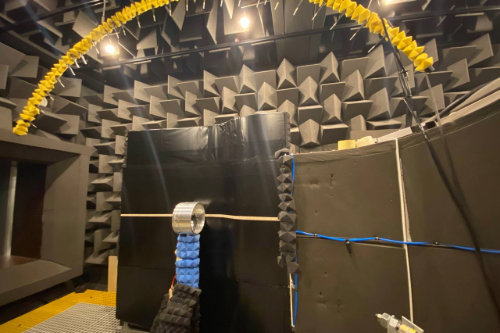
BLI ducted fan test rig inside the anechoic chamber at the University of Bristol, featuring a ducted fan mounted on the curved S-plate and an overhead microphone array for aeroacoustic measurements.Dr Feroz Ahmed
A breakthrough study has revealed why emerging electric aircraft engine technology sounds so annoying - and how to fix it.
Scientists at the University of Bristol in collaboration with the University of Salford have uncovered the root cause behind the particularly irritating noise produced by boundary layer ingesting (BLI) engines — a key technology in future electric and hybrid aircraft.
Building on earlier work that identified general noise sources in BLI systems, this latest research, published today in Nature npj Acoustics, dives deeper into the physics of aerodynamic sound generation, revealing how turbulent boundary layer flow interacts with rotating fan and duct components to produce two distinct and perceptually unpleasant acoustic signatures.
Key to this research is a fluid-mechanics-based assessment that uncovers the fundamental aerodynamic origin of two different types of broadband noise patterns, known as 'haystacking' — spectral features that affect how noise is perceived. In acoustics, 'haystacking' describes the effect of turbulent flow scattering tonal sound fields, causing the energy of a specific tone to be spread across a wider range of frequencies.
The study shows that at low thrust (during cruise), the weaker fan suction allows the airframe boundary layer flow to remain largely undisturbed. In this regime, flow ingestion is governed by airframe curvature-induced flow distortion, which exposes only the blade tips to low-momentum turbulent flow structures. Since the duct's acoustic contribution dominates at low thrust, the primary noise-generating mechanism is the interaction between the turbulent flow and the duct's internal acoustic field — resulting in duct haystacking.
At high thrust (during take-off), strong fan suction disrupts the airframe boundary layer flow, producing fan-induced flow distortion that draws in high-momentum, highly-unsteady turbulent flow structures across a larger portion of the blade span. This intense interaction between fan-induced distorted flow and rotating blades leads to fan haystacking, where the unsteady flow is repeatedly sliced by the rotating blades by a large portion of the rotating blade span.
Lead researcher Dr Feroz Ahmed, who was based in Bristol's Faculty of Science and Engineering, while conducting this study, said: "These two hidden sound signatures — haystacking — make future embedded aircraft engines feel perceptually irritating, not just loud.
"By linking turbulent flow ingestion patterns to how people perceive noise, we are giving engineers the tools to design future aircraft that truly sound as quiet as they look."
These insights offer a new roadmap for designing embedded engines that sound quieter, not just measure quieter – a vital step for improving public acceptance of future urban air mobility aircraft.
Using a high-fidelity wind tunnel setup that replicates real-world conditions, researchers gathered detailed flow and noise data across flight regimes using advanced instrumentation — including hot-wire anemometry, pressure sensors, and far-field microphones. This allowed them to isolate and connect each noise signature (haystacking) to both its aerodynamic cause and its impact on human perception.
The implications of this research are wide-ranging. These insights provide actionable design guidance for both large-scale transport aircraft — such as the Airbus ZEROe, ONERA NOVA, NASA/MIT Aurora D8, Airbus Nautilus, and MITSAX-40 — and for manufacturers of next-generation electric vertical take-off and landing (eVTOL) aircraft in the urban air mobility (UAM) sector, supporting efforts to meet the EU's FlightPath 2050 goal of reducing aircraft noise by 65%. These findings could help design perceptually quieter engines for future electric aircraft and air taxis.
The team now plans to develop aerodynamic and acoustic control strategies to reduce both fan and duct haystacking. They are also looking to expand this analysis to other propulsion concepts involving turbulent flow ingestion, with the aim of shaping the future of quiet aviation.
Paper:
'Aeroacoustics and psychoacoustics characterization of a boundary layer ingesting ducted fan' by Feroz Ahmed, Carlos Ramos-Romero, Antonio J. Torija and Mahdi Azarpeyvand in Nature npj Acoustics.






